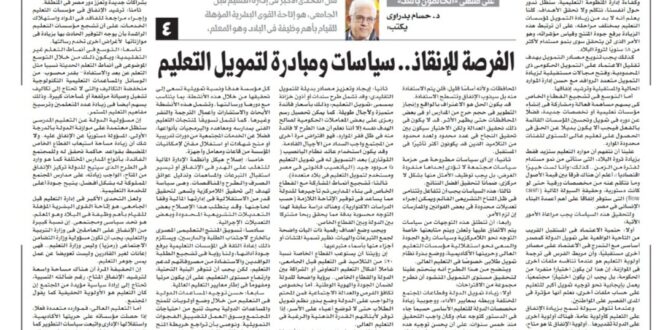The opportunity to rescue (4)
Policies and an initiative to finance education
By
Hossam Badrawi
Without a clear philosophy and vision, honesty with oneself, and efficient management of the educational system, we will continue to go around talking and not achieve the goals. We all know that funding for educational institutions at all levels must be increased, provided that this increase is linked to raising the quality of the product and measuring its indicators, which will not be achieved except with a sustainable growth of more than 8% annually in the country’s wealth.
Funding sources must also be diversified in order to reduce dependence on limited government funding and open future areas to increase multi-source funding while managing current and future resources well and rationalizing their spending..
As for expanding the encouragement of the private sector to contribute effectively and participate in establishing educational institutions or new specializations, in addition to its role in financing and improving existing institutions, it must not be an alternative to the right to obtain high-level education for groups with limited resources.
We must understand that education resources will only increase with the increase in the country’s wealth, which will come from sustainable growth for a period of time.. Also, I am not an economic expert; I know that there is a difference between the value of assets and what we are talking about in terms of paper allocations, even if they are constitutional, and the reality of cash flow that will provide spending on the most important pillars of human construction in Egypt.
To achieve these policies, the following matters must be taken into account:
First: The inevitability of relying in the near future from a realistic perspective on state funding as a primary source, with a gradual reliance on other sources in the future. The crux of the matter in translating the priority of education is when other files compete with it in the budget. This will not be a single choice by the government, but rather it must be a societal choice that works positively towards directing greater funding to education at the expense of other files, which we know have an impact on citizens in the short term.
When there is liquidity that allows for increased spending on education as a general priority, there is another priority that the state must estimate… the priority of spending on what is available, and there are difficult choices for us to consider…
Is spending incidentally on all education in all governorates? Because it is basically small, it will not be used, rather spending will melt away and the benefit will be flattened. The solution may be to acknowledge the reality and achieve development in a critical number of schools or in some governorates until the impact appears. This may not achieve justice, but the choice will be between achieving success in a limited number and for a limited number of students who may be more influential in the future..
Second: Any proposed policies are a package of combined policies, none of which alone achieves the purpose, but rather the best of them must be employed in a decentralized manner, to ensure achieving the best results.
Third: These policies must interact and grow in light of the existing legislative climate, and limited amendments can be made to some laws and practices if necessary.
Fourth: These trends should be based on policies that are agreed upon, announced, and followed up, especially the trend towards decentralization, policies to raise quality, and the pursuit of independence and academic freedom of higher education institutions, and laying the seed of a student financing system, especially in higher education.
It is clear from this proposal that in order to achieve the desired level of funding, we must put forward a set of proposals:
First: Increase state funding and various sectors of society and link it to performance standards and the necessity of increasing allocations The state for basic education as stated in the constitution as a general direction and it was necessary to achieve five years ago, so that this budget should be directed to schools, universities and institutes in rural areas and greater allocations should be given to localities. Second: Finding and strengthening alternative sources of traditional financing: This may include issuing bonds or treasury bills under the name of “Education Financing” at distinguished interest rates and for long periods. A symbolic fee can also be collected on some government transactions for the same purpose, but we know that this proposal is useless in light of the poverty of resources, as it is another borrowing from society that must be repaid by future generations..
Using the proceeds of the lottery system after marketing it to finance education may have a good return (the lottery is legal in Egypt and is used to finance education in many countries).
Third: Encouraging patterns of participation with the private sector in building schools and then leasing them to the state, which helps in providing the necessary availability according to actuarial studies) and there is a previous study of this trend that is carefully calculated, which achieves a joint profit between the state and the private sector.
Numeric goals must be set with clear mechanisms for collecting donations and gifts, in exchange for naming facilities or parts of them after their donors.
Our vision is for the private sector to absorb 20% of students in pre-university education, including forms of cooperative education or partnership between the state and the private sector.. with a clear vision for the state to ensure quality and national identity. As for equal opportunities and social justice, it is imperative and obligatory for the state to plant the seeds of student financing systems so as not to place burdens on families, if their children have the mental capacity and desire for higher education. Fourth: Relying on scientific research and community activities as sources of funding: Each institution determines a goal and a funding percentage that it seeks to achieve through these activities, in a manner consistent with its role and mission. These activities include research, consultations, translation, publishing, etc. They also include marketing of technical education products in its schools and institutes and software of all kinds, in addition to community services such as training courses, granting certificates, or regulated exploitation of the institution’s capabilities of halls, laboratories, and equipment.
Fifth: Reforming the structure and systems of financial management to overcome waste in spending or facilitate the reception of donations and contributions and remove obstacles to spending, offering and tenders. It is a policy that aims to achieve decentralization and seeks to achieve a degree of independence in its financial management according to its needs. This reform may require some limited legislative amendments and some procedural amendments.
Sixth: Marketing the Egyptian educational product abroad to attract students and scholars, and this requires restoring confidence in educational institutions by raising the quality of their performance. We have a vision to encourage incoming students and benefit from their expenses to support education, but the infrastructure must be available, and the level of education must be high, so that it is visible and understandable within the framework of international education standards.
Seventh: Good direction of international aid in education by setting priorities for grants and international aid so that they stem from the needs of society and the labor market to narrow the funding gaps. We recommend that the map of foreign grants and international agreements be reviewed to encourage foreign investments in education and to conclude new agreements that serve this purpose and initiate new partnerships and enhance Egypt’s role in the region.
Eighth: Rationalize spending in educational institutions and conduct a review of the loss of materials and consumption of services, provided that mature educational institutions are encouraged to meet the savings that occur in them with an increase in their budgets that are directed to other purposes that serve their mission.
Ninth: Expand non-traditional learning patterns: This is done through objective expansion in relatively modern learning patterns such as distance learning and benefiting – to a calculated extent – from low-cost technological educational means and aids that do not require high operating and maintenance costs or large areas. This also contributes to increasing the number of learners and consolidating the concepts of continuous education.
The state’s responsibility for school education will remain primarily dependent on the state budget, which is constitutionally responsible for spending on it. There is no doubt that increasing the capacity of the private sector, which is disciplined by governing rules that will benefit it and society, with different types of schools as stated in the proposal, will allow the state to focus spending from the available, which must be increased, on the community schools owned by it in a better way, allowing for a higher quality of educational service.
Perhaps the biggest challenge in managing pre-university education is providing qualified human resources to perform the most important job in the country, which is the teacher. It is a political and societal challenge. A large percentage of spending on employees in the Ministry of Education should be the responsibility of the Ministry of Social Solidarity (symbolically) and not the Ministry of Education. It is subsidies for the incapable and not compensation for work that affects the essence of education.
The bitter truth is that there is a wide space for rationalizing available spending, despite its relative smallness, which requires political will supported by society if education is the real priority, as society says.
As for higher education, its resources are actually multiple, if its institutions obtain their academic freedom and administrative independence And we followed the development policies as we mentioned. The truth is that higher education institutions are the opportunity, not the ordeal that we face.
 Dr. Hossam Badrawi Official Website
Dr. Hossam Badrawi Official Website


